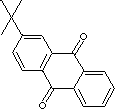PRODUCT IDENTIFICATION

CLASSIFICATION
PHYSICAL AND CHEMICAL PROPERTIES
yellow crystalline powder
REFRACTIVE INDEX
210 C
APPLICATIONS
APPEARANCE
yellow crystalline powder
98.0% min
INSOLUBES
0.1% max (in benzene)
|
|
|
| 2-TERT-BUTYLANTHRAQUINONE | ||
|
PRODUCT IDENTIFICATION |
||
| CAS NO. | 84-47-9 |
|
| EINECS NO. | 201-531-2 | |
| FORMULA | C18H16O2 | |
| MOL WT. | 264.32 | |
| H.S. CODE | ||
| TOXICITY | ||
| SYNONYMS | 2-(1,1-Dimethylethyl)-9,10-anthracenedione; | |
| 2-tert-Butyl-9,10-anthraquinone; 2-tert-Butylanthra-9,10-quinone | ||
| SMILES |
|
|
|
CLASSIFICATION |
|
|
|
PHYSICAL AND CHEMICAL PROPERTIES |
||
| PHYSICAL STATE |
yellow crystalline powder | |
| MELTING POINT | 98 - 103 C | |
| BOILING POINT | ||
| SPECIFIC GRAVITY | ||
| SOLUBILITY IN WATER | Insoluble | |
| AUTOIGNITION | ||
| pH | ||
| VAPOR DENSITY | ||
| NFPA RATINGS | ||
|
REFRACTIVE INDEX |
||
| FLASH POINT |
210 C | |
| STABILITY | Stable under ordinary conditions | |
|
APPLICATIONS |
||
| Anthraquinone, a polycyclic aromatic hydrocarbon containing two opposite carbonyl groups (C=O) at 9,10 position, is yellow or light gray to gray-green crystal powder; insoluble in water. , In nature, it occurs in plants (aloe, cascara sagrada, senna, and rhubarb), fungi, lichens, and insects as a parent material for coloring of yellow, orange, red, red-brown, or violet. It is commercially produced by several ways including by oxidation of anthracene with chromic acid, the condensation of benzene and phthalic anhydride, followed by dehydration for cyclization, and diene Diels-Alder reaction. Anthraquinone is the most important quinone derivative of anthracene as the parent substance of a large class of dyes and pigments. One of the oldest mordant dye, alizarin, is the anthraquinone derivative. Anthraquinone is a starting material for the production of coloring compounds, antioxidants, and polymerization inhibitors. Its derivatives are widely used as intermediates for dyes, pigments, photographic chemicals, and paints. Anthraquinone is used in paper industry as a catalyst to increase the pulp production yield and to improves the fiber strength through reduction reaction of cellulose to carboxylic acid. Natural anthraquinones have cathartic properties. Anthraquinone derivatives are also used in manufacturing drugs. Mitoxantrone, an antineoplastic is an example. 2-Ethylanthraquinone is an intermediate for the synthesis of dyes. It is also used as a catalyst for the production of peroxide compounds. 2-tert-Butylanthraquinone is an intermediate for the synthesis of colorants. It is also used as a catalyst for the production of peroxide compounds. | ||
| SALES SPECIFICATION | ||
|
APPEARANCE |
yellow crystalline powder | |
| CONTENT |
98.0% min | |
|
INSOLUBES |
0.1% max (in benzene) | |
| MELTING POINT | 98 - 103 C | |
| TRANSPORTATION | ||
| PACKING | 25kgs in bag | |
| HAZARD CLASS | ||
| UN NO. |
| |
| OTHER INFORMATION | ||
| Hazard Symbols: n/a, Risk Phrases: Safety Phrases: 24/25 | ||
|
|
|